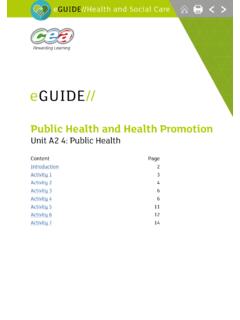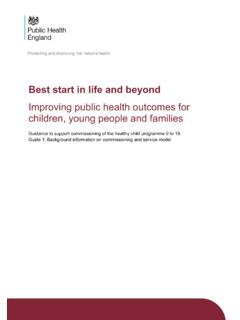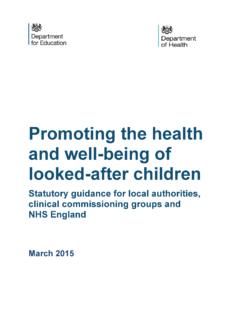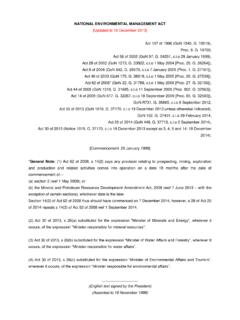Transcription of Association of Massage Therapists - Massage Therapy Code ...
1 Massage Therapy Code of Practiceassociation of Massage therapistspage 2 ACKNOWLEDGEMENTSThis Code of Practice would not have come into being without the effort, commitment and energy of a number of people. Special acknowledgement is due to Rebecca Barnett, Tamsin Rossiter and Desley Scott who researched and wrote most of the standards contained in this document. Sincere thanks and acknowledgement also go to: Alan Ford and Linda Hunter, who drafted three of the Standards in the Code Beth Wilson and Grant Davies (Office of the health Services Commissioner, Victoria) and Professor Michael Ward ( health Quality and Complaints Commission, Queensland) who provided invaluable feedback and insight Colin Rossie, whose research and contributions to the Code of Practice Wiki helped to maximise stakeholder engagement in the process Annette Cassar and Jodee Shead, who assisted in the review process Linda White, Paul Lindsay and Katie Snell, who proofed the document All those who took the time to read the draft Code and provide by Claudia Iacovella Graphic Designer Email: M.
2 0417 073 383 page 3 Association of Massage Therapists LtdThis material is copyright Association of Massage Therapists Ltd (AMT ). You may download, store in cache, display, print and reproduce the material in unaltered form only (retaining this notice, or links to it where they appear) for non-commercial use or use within your organisation. You may not deal with the material in a manner that might mislead or deceive any person. You may not reproduce this material without acknowledging AMT's from any use as permitted under the Copyright Act 1968, all other rights are reserved. Requests for further authorisation should be directed to: Association of Massage Therapists LtdPO Box 826 Broadway NSW 2007P: 02 9211 2441E: 4 About AMT 5 AMT Code of Ethics 6 Massage Therapy Code of Practice - Delivering quality care to Australian consumers 7 AMT Standard - Complaint Handling 15 AMT Standard - Professional Boundaries 19 AMT Standard - Draping 23 AMT Standard - Informed Consent 27 AMT Standard - Breast Massage 31 AMT Standard - Privacy and Confidentiality 35 AMT Standard - Record Keeping 39 AMT Standard - Issuing Receipts 45 AMT Standard - Advertising 49 AMT Standard - Infection Control and Hygiene 53 AMT Standard - Work health and Safety 57 AMT Standard - Dry Needling 63 AMT Standard - Treatment of Minors 67 ABOUT AMT page 5 VisionAustralians have access to safe.
3 Ethical and evidence-informed Massage Therapy treatment within the Australian health care encourage our members to connect and engage with colleaguesWe have set the agenda for industry advocacy since 1966We strive for the highest standards of transparency and accountabilityWe support our members to deliver evidence informed, skilled and ethical careWe put quality and safety of care at the heart of our agendaBest practiceParticipationLeadershipOpennessC lient focusAMT valuesOur mission is to: Support our members Professionalise practice Educate and inform the public and other healthcare professionalsThe Association of Massage Therapists (AMT) is a national, not-for-profit Association representing qualified Massage Therapists and Massage Therapy Students. Established in 1966, AMT is the oldest Association in Australia to represent Massage Therapy in its own right and the premier representative body for professional of ethicsAs a member of the Association of Massage Therapists , I commit myself to the highest standards of practice:I will.
4 Care for the health , wellbeing and comfort of my clients with the utmost skill appropriate to my current qualifications respect the privacy, modesty and dignity of my clients and maintain appropriate professional boundaries respect the beliefs, rights and values of my clients protect the confidentiality of my clients personal information refer clients to an appropriate therapist if their needs are outside my scope of practice and training respect my fellow Therapists in all disciplines commit myself to continuing professional development, sharing technical skills and raising professional standards endeavour to enhance the reputation of the Massage Therapy profession support the Association of Massage Therapists in all its ideals, principles, codes and standards refrain from conduct that adversely affects the reputation of the Association of Massage Therapists or the Massage profession comply with the AMT Code of Practice and all applicable State, Territory and Federal lawsMassage Therapy Code of Practice - Delivering quality care to Australian consumers page 7 Association of Massage Therapists LtdMassage Therapy Code of PracticeDelivering quality care to Australian consumersINTRODUCTIONThe Massage Therapy standards contained in this Code have been set down by the Association of Massage Therapists Ltd (AMT )
5 To provide a formal framework for the safe and ethical practice of Massage Therapy in Australia, and to assist practitioners in applying risk management policies and procedures in their clinic or workplace. The Standards have been formalised to help practitioners understand and meet their professional duty of care. In the context of Massage Therapy practice, duty of care pertains to the Massage therapist s ethical and legal obligation to avoid acts or omissions that are likely to cause harm to their clients. It is the appropriate and responsible application of professional knowledge, skill and the context of Massage Therapy practice, professional misconduct is defined as a violation of these ethical standards a failure to meet or a breach of this Code of Practice. The Code clearly and comprehensively sets out AMT s position if called upon to give Expert Witness evidence in court cases for criminal negligence or assault.
6 It is the Massage therapist s responsibility to formulate a risk management framework around the standards articulated in this Code of developing this Code of Practice, AMT is honouring its commitment to protect the public and serve its members, by promoting the safe and ethical practice of Massage Therapy . The Code should serve as a reference for: Therapists to better understand their ethical, legal and professional obligations Educators to incorporate in the delivery of health Training Package qualifications Allied health professionals to assist in making appropriate health referrals Disciplinary bodies to provide a benchmark against which complaints can be assessed Legal authorities to inform criminal and civil investigations and proceedings The public to empower clients to assess the quality of their care against an objective Massage Therapy Code of Practice is a living document that will evolve in line with changes in practice and 8 Massage Therapy Code of Practice - Delivering quality care to Australian consumers Association of Massage Therapists LtdLEGISLATIVE CONTEXTM assage Therapy is currently self-regulated in Australia.
7 There is no Statute or Act that applies solely or specifically to the practise of Massage . However, Massage Therapists are accountable under the following statutory codes and legislative instruments:Federal The Privacy Act 1988 Privacy Amendment (Notifiable Data Breaches) Act 2017 Competition and Consumer Act 2010 (which includes the Australian Consumer Law) Work health and Safety Act 2011 Work health and Safety regulations 2011 Fair Work Act 2009 Australian Charter of Healthcare RightsNSW public health Act 2010 health Care Complaints Act 1993 health Records and Information Privacy Act 2002 Children and Young Persons (Care and Protection) Act 1998 NSW Code of Conduct for Unregistered health PractitionersACT health Act 1993 health Records (Privacy and Access) Act 1997 Children and Young People Act 2008 Working with Vulnerable People (Background Checking)
8 Act 2011 Human Rights Commission Act 2005 Victoria health Records Act 2001 health Complaints Act 2016 Working with Children Act 2005 Occupational health and Safety Act 2004 Code of Conduct for General health ServicesQueensland health Ombudsman Act 2013 Child Protection Act 1999 National Code of Conduct for health Care Workers (Queensland)South Australia health and Community Services Complaints Act 2004 Children and Young People (Safety) Act 2017 SA Code of Conduct for Unregistered health PractitionersWestern Australia health Services (Conciliation and Review) Act 1995 Information Privacy Bill 2007 Working with children (Criminal Record Checking) Act 2004 health and Disability Services (Complaints) Act 1995 Occupational Safety and health Act 1984 Occupational Safety and health regulations 1996 Tasmania health Complaints Act 1995 Children, Young Persons and their Families Act 2013 Northern Territory health and Community Services Complaints Act 1998 health and Community Services Complaints regulations 1998 Code of health and Community Services Rights and Responsibilities Care and Protection of Children Act 2007 Massage Therapy Code of Practice - Delivering quality care to Australian consumers page 9 Association of Massage Therapists LtdSCOPE OF PRACTICEThe practice of Massage Therapy is the purposeful, respectful and evidence-informed application of touch, manual techniques and biopsychosocial care.
9 As a client-centred framework it aims to: enhance health and wellbeing relieve pain provide emotional and physical relaxation reduce stress and alleviate the impacts of depression and anxiety prevent and repair injury rehabilitate and augment function. Massage Therapists treat a wide variety of conditions including: persistent pain neck and back pain, and headache muscle, connective tissue and joint pain arthritis sports and activity-related conditions stress, anxiety, depression and other mood related problems..EDUCATION STANDARDSM assage Therapists have: a detailed knowledge of anatomy, physiology and biomechanics well-developed assessment, observational and palpatory skills expertise in a range of manual Therapy techniques and approaches an understanding of normal function in relation to the soft tissues of the body and the ability to recognise dysfunction, including knowledge of cautions and contraindications to Massage Competency Standards were introduced for Massage Therapy in 2002 as part of the health Training Package.
10 Nationally recognised Massage Therapy qualifications at Certificate IV, Diploma and Advanced Diploma Levels are delivered by Registered Training Organisations (RTOs) which are regulated by the government. These qualifications sit within the Australian Qualifications Framework (AQF), the national system of qualifications encompassing higher education, vocational education and training, and of Certificate IV programs are competent to perform general health maintenance of Diploma programs are competent to perform treatments involving specific techniques to alleviate common musculoskeletal presentations such as low back of Advanced Diploma programs are competent to treat complex musculoskeletal presentations with a more extensive range of treatment who were trained prior to the introduction of National Competency Standards in 2002 should be able to demonstrate equivalency at Certificate IV.







